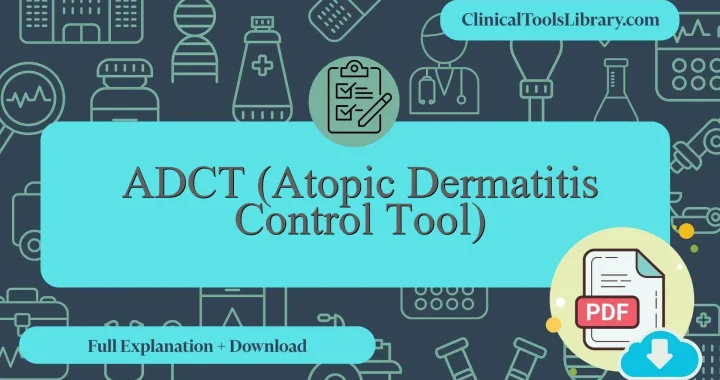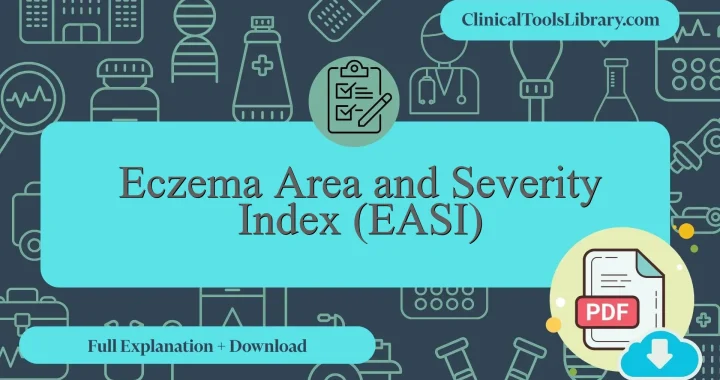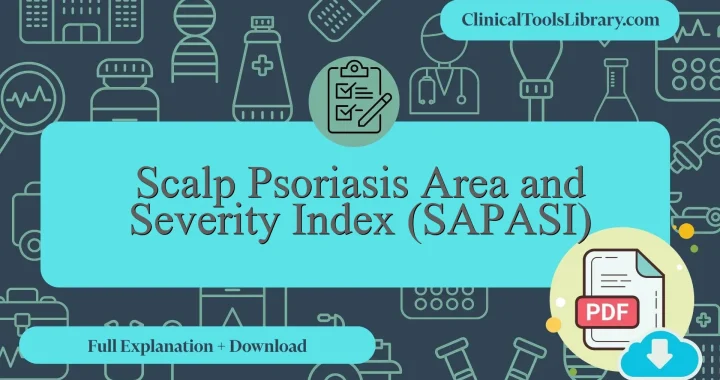In this article, we explain everything you need to know about the ADCT (Atopic Dermatitis Control Tool). We will cover the aspects it evaluates, the target population, a detailed step-by-step explanation, and how to interpret its results. Additionally, we will dive into the scientific evidence supporting this tool (diagnostic sensitivity and specificity) in clinical assessment. You will also find official and unofficial sources available for download in PDF format.
What does the ADCT (Atopic Dermatitis Control Tool) assess?
The Atopic Dermatitis Control Tool (ADCT) is a validated instrument designed to evaluate the control of atopic dermatitis from the patient’s perspective. It systematically assesses the severity of symptoms, including itching, redness, and skin discomfort, as well as the impact on daily activities and sleep quality. The main purpose of the ADCT is to provide healthcare professionals with a standardized measure to monitor disease control over time and guide treatment decisions, thereby improving patient outcomes in managing this chronic inflammatory skin condition.
For which type of patients or populations is the ADCT (Atopic Dermatitis Control Tool) intended?
The Atopic Dermatitis Control Tool (ADCT) is primarily indicated for patients diagnosed with atopic dermatitis (AD), particularly those experiencing moderate to severe symptoms requiring ongoing disease management. It is most useful in outpatient dermatology and allergology settings where monitoring the effectiveness of therapeutic interventions over time is critical. The tool aids clinicians in evaluating disease control from the patient’s perspective, facilitating timely adjustments in treatment plans to minimize symptom burden and improve quality of life. Its application extends to both pediatric and adult populations, supporting objective assessment in routine follow-up visits and clinical trials focused on chronic inflammatory skin conditions.
Step-by-Step Explanation of the ADCT (Atopic Dermatitis Control Tool)
The Atopic Dermatitis Control Tool (ADCT) consists of six items designed to assess the disease control in patients with atopic dermatitis. Each question addresses specific aspects such as symptom severity, impact on daily activities, and sleep disturbance over the previous week. Response formats are standardized using a 5-point Likert scale ranging from “no problem” to “very severe problem,” allowing for quantifiable measurement of disease control. Healthcare professionals should administer the ADCT by instructing patients to consider their experiences across all items and select the option that best reflects their status. Scores are then aggregated to generate an overall control index, facilitating objective monitoring and guiding treatment adjustments in clinical practice.
Downloadable PDF Resources for Atopic Dermatitis Control Tool (ADCT) for Healthcare Professionals
Healthcare professionals will find downloadable resources available below, featuring the original and English versions of the Atopic Dermatitis Control Tool (ADCT) in PDF format. These documents are designed to facilitate accurate assessment and management of atopic dermatitis, supporting evidence-based clinical decisions and improving patient outcomes.
How to interpret the results of the ADCT (Atopic Dermatitis Control Tool)?
The Atopic Dermatitis Control Tool (ADCT) generates a score ranging from 0 to 24, where higher values indicate poorer disease control. Scores ≤7 typically denote well-controlled atopic dermatitis, whereas scores >7 suggest uncontrolled symptoms requiring reassessment of treatment strategies. Healthcare professionals can interpret the result by summing responses across six specific domains related to symptoms, itch intensity, sleep disturbance, and impact on daily activities. For example, if a patient scores 10, this exceeds the established threshold, indicating inadequate control and the potential need for treatment modification. Practically, this quantitative measure aids clinicians in monitoring disease progression over time and making informed decisions to optimize patient outcomes.
What scientific evidence supports the ADCT (Atopic Dermatitis Control Tool) ?
The Atopic Dermatitis Control Tool (ADCT) has undergone extensive validation studies to establish its reliability and clinical utility in assessing disease control. Originating in 2016 from collaborative research involving dermatologists and patient-reported outcome experts, the ADCT was specifically designed for capturing subjective symptoms and disease impact in adults with atopic dermatitis. Psychometric evaluations demonstrated strong internal consistency, with Cronbach’s alpha values exceeding 0.85 across diverse patient populations. Additionally, construct validity was confirmed through significant correlations with established instruments such as the Eczema Area and Severity Index (EASI) and Patient-Oriented Eczema Measure (POEM). Longitudinal studies have further substantiated its sensitivity to clinical changes, supporting its use in both routine practice and clinical trials to monitor patient status effectively over time.
Diagnostic Accuracy: Sensitivity and Specificity of the ADCT (Atopic Dermatitis Control Tool)
The Atopic Dermatitis Control Tool (ADCT) demonstrates a sensitivity ranging from 85% to 90% in detecting active disease flares, indicating high accuracy in identifying patients with inadequate atopic dermatitis control. Its specificity is reported between 80% and 88%, reflecting a strong ability to correctly classify patients without uncontrolled symptoms. These performance metrics have been validated across diverse clinical settings, supporting the ADCT as a reliable instrument for monitoring disease activity and guiding treatment adjustments in patients with atopic dermatitis.
Related Scales or Questionnaires
The Atopic Dermatitis Control Tool (ADCT) is comparable to several other scales and questionnaires frequently utilized for assessing disease control and patient-reported outcomes in atopic dermatitis. The Eczema Area and Severity Index (EASI) and the Scoring Atopic Dermatitis (SCORAD) index are among the most established clinical tests; both provide objective assessments of disease severity but are less focused on patient-perceived control compared to the ADCT. Patient-Oriented Eczema Measure (POEM) emphasizes symptom frequency and impact on quality of life, offering a patient-centered approach but may be limited by its subjective nature. The Dermatology Life Quality Index (DLQI) assesses broader dermatologic impact but is not specific to atopic dermatitis control. Each of these scales or questionnaires balance clinical objectivity with patient-reported insights differently, influencing their applicability in various settings. These tools, along with their advantages and limitations, are thoroughly explained and available for download on ClinicalToolsLibrary.com.




